|
I have always been drawn to the Nankoweap region of the Grand Canyon, perhaps in large part due to the difficulty I had in getting to this area. I first hiked here in 1983, and have done a number of interesting trips into this canyon. This trip was prompted by my desire to search out a rather obscure route into, and out of, Nankoweap called the ďKibbey Butte Route.Ē It is an access from the North Rim. On the face of it, the description defies common sense - a ropeless route (save for lowering/raising packs a couple of times) that has an elevation change of approximately 2500 feet over a horizontal distance of less than a half mile. Seemingly quite mad, and the allure is obvious. There are precious few places in the Grand Canyon where this is possible. Our common perception of the canyon being comprised of sheer barrier cliffs is not without reason. However, this route takes one through, from top to bottom, the Kaibab limestone, the Coconino sandstone, the Supai group of sandstones and limestones and the Redwall limestone cliff layers. The namesake of this route is Kibbey Butte, a very unassuming formation in the Hermit shale level, peaking below the Coconino sandstone cliffs. Easily visible from the popular Point Imperial viewpoint, on the North Rim, it would likely be the last thing any visitor there would notice. Indeed, from this vantage point, a route from rim to canyon floor looks quite impossible. But, the route is blessed with two huge advantages. One is an easy bushwhack through the forested rim to the bottom of the Coconino level. The other is an utterly easy and narrow chute through the Redwall. The heart stopper is the upper 100-150 feet of Supai. Two of the canyonís best known hikers/explorers spent much time and energy piecing together this route, over a number of forays into this area, although they were separated in time by some two decades. Harvey Butchart, the celebrated master of Grand Canyon hiking, in the company of sometime hiking companion George Beck, actually made an aerial survey of this route in the 1960s. Butchartís original bypass of the tricky Supai led him to a miserable contour above the Redwall in order to get to the appropriate ďfault ravine.Ē It took him a number of climbs through here before finding a suitably direct way through the Supai. Although his description of this route is included in the voluminous trail logs he has bestowed upon the Cline Library at Northern Arizona University, it didnít make it into any of his three hiking books. George Steck, whose hikes in the canyon were legendary before he wrote two books describing fabulously attractive loop hikes here, independently sought and found this same route through the Supai. Like Butchart, Steck also conducted an aerial survey, although this time in the mid-1980s. With a number of false tries, both from the top and the bottom, he also finally succeeded in identifying the proper route through the Supai. The description is well-written up in Steckís second book, Grand Canyon Loop Hikes II. |
|
|
||
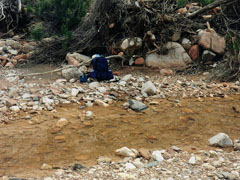 My pack along the creek. |
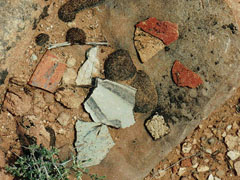 Pottery sherds at some ruins. |
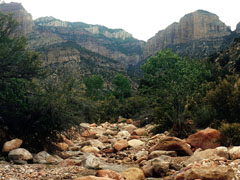 Looking up the creek. |
 Upper creek bed. |
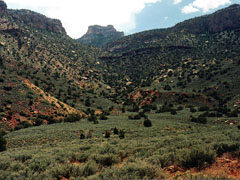 The view to Swilling Butte. |
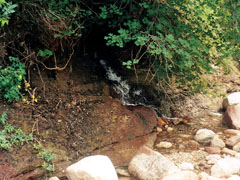 The upper spring; no water past this. |
|
I did face one serious concern. I am no madman, and am easily turned away from climbing through spots that present any exposure. Especially when hiking alone. But, for this hike, that place would come some 2000 feet above me, high in the Supai. It would be there that I would be faced with the potential of having to turn around and backtrack my way out of the canyon. The fact that Butchart and Steck had come through this route wasnít enough for me. I have lots of Grand Canyon experience, but I am no Butchart. And, I am no Steck. I knew that I would use up much of the day getting to this spot, and if I had to turn around, I figured that it would be imperative that I be able to get back to the spring before dark, and out the day after that. I didnít really pack a whole extra dayís worth of food, but had enough to nurse me through another 24 hours. I didnít want to have to turn around, but the probability of that happening seemed greater as I looked up this boxy canyon, with its sheer cliffs. The spring was actually very noisy. The water gushed out of the side of the ravine in two places, probably flowing at a gallon a second, although my estimate is likely to have a huge margin of error. I suppose that one may call this ďnatural noise,Ē and worthy of some particular respect. However, I find it extremely difficult to sleep near this kind of water source, so I spent a long while finding a suitable spot to camp, far enough away so that it was not distracting, but close enough so that filling up my water bottles wasnít a burdensome chore. The area was quite brushy, and I barely found a place to lay out my air mattress. A tent would have been out of the question. For the rest of the day, I did very little, but drink water, rest and eat. For those that think a hiking story must include a favorite recipe, here is mine for that eveningís dinner: Get two slices of bread from the plastic container. Open one of the individual packages of mayonnaise (courtesy of Chic-Fil-A) and a package of horseradish sauce (from Arbyís). Spread generously. Open a 5 ounce can of chuck chicken (chunk ham may be substituted instead, although then I will likely use mustard instead of the horseradish). Scoop and spread on the bread. Put both pieces of bread together and eat. Hold the lid of the plastic bread container underneath the sandwich so as to catch any that should fall. For dessert, open up an 8 oz. can of sliced pineapples and eat directly from the can. The evening was cool, and I wore some polys to go along with my sheet, and I ended up putting my poncho over me, to further retain heat. My air mattress turned out to be a big disappointment, as it leaked. Once I laid down, hardly ten minutes would elapse before it would go flat. As a consequence, I tossed and turned most of the night, unable to find a comfortable position for very long. And, as to be expected, I finally seemed to fall into a deep sleep about an hour before I had wanted to get up in the morning. |
|
|
||
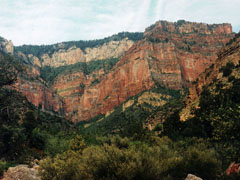 |
 |
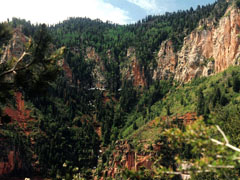 |
| Looking up Nankoweap. Kibbey is above the Supai on the right. | Looking
back down the canyon from the Redwall chute. |
The
head of the drainage from above the Redwall. |
| Now near the
base of Kibbey, I was on familiar ground. I had been down here, from
the rim, a couple of years ago. Although tedious, and sometimes very
steep through the forested pines, from here I was on the rim in less than
an hour. Some three hours after that I arrived back at my truck,
having picked up my water cache along the way. It was a simply
fabulous hike. |
|
Appendix 1 - The Kibbey Butte Route Map I had drawn a map on a piece of paper which I still have. But, I know I copied it onto a 3x5 note card for the hike and I can't find that. The roughed out sketches are not especially great, so I decided to put it together again, below, using some photos I took during the hike to highlight certain features. All of these photos appear in the text, above. The map is based on George Steck's description given on pages 130-131 of Grand Canyon Loop Hikes II.
|
|
Appendix
2 - Micro-cassette
Transcript Friday,
May 16th, 1997 and am beginning to leave from Flagstaff for the hike up
the Kibbey Butte route. It
is 2:46 and Iím just leaving the gas station at Flagstaff.
The mileage is 39,648.1. The
weight of my pack is 25 pounds exactly. Itís
4:38. The mileage is 120.8,
from Flagstaff, and Iím right now crossing Navaho Bridge, arriving
here at Marble Canyon. Itís
5:27, and Iím just leaving Jacob Lake.
Stopped here to get some gas and reset the odometer.
It is sunny and partly cloudy--got some rain down around Cliff
Dwellers and in that area. And,
now, on to the North Rim. The
forest road that goes off to the east and the west, leading to all kinds
of points, including Nankoweap trailhead, [is] 27.1 miles past Jacob
Lake. Itís
6:01--Iíve just entered the park. Itís
6:21. The miles are
39,859.6 and Iím right at the rim where the Ken Patrick trail is, to
check it out. Saw some snow
on the way in, and Iím hoping itís not going to be a big problem
here, off the side. [This
is the water cache spot.] It is 8:17. The miles are 39,906.5--have come 95.1 miles from Jacob Lake and Iím now at the Nankoweap trailhead. Thereís a couple of vehicles parked over nearby--donít know that I saw a tent anywhere. It seems like it may rain a little bit tonight, so looks like I may be setting up the tent. [I did set up the tent, but it did not rain. When I arrived here, after first going to the lodge and eating a quick dinner out on the balcony--pizza slice and a salad--it was dark.]
It
is Saturday, May 17th. The
time is 5:34 and Iím just getting ready to go here.
All ready to head down. The
sun has been up for as bit. I
did get up at 4:30, but it takes about an hour to get ready to get
going. There are a couple
of vehicles here and it looks now like there isnít anybody camped, so
they must be down the trail. It
is 6:35 and I am at the trailhead on the saddle.
The route down was pretty nice.
At the top the trail has been cleared away a lot, so itís real
easy going. Once you get
past the big plateau the brush is still a little bit intrusive. Had to cross a snowpack over one little stretch too, so it
was kind of an odd little outcome.
Real nice day--clear, breezy, but very pleasant up here, which
makes me think itís going to be very hot down there.
So, on to Marion Point. It
is 7:30 and I have stopped in the shade of a tree, somewhat past Marion
Point. I thought I might
catch an overhang here with some nice shade, but itís catching some of
the early morning sun. But,
still, itís a pretty nice spot right here.
Iím going to take a little break, have some water, put some
sunscreen on my arms and get this long sleeved shirt off.
Itís still pretty nice. Of
course, weíre still pretty high here in this section.
But, time is going real well.
There are about six, or seven, hikers ahead of me, on the other
side of this bay. I suppose I may be meeting up with them, or passing them,
somewhere by Breezy Point, it would seem.
So, anyway, take a little break here.
It is still very clear, and quite calm, right here anyway. Itís
7:55 and Iím ready to leave this little spot and continue on my way. Itís
8:51 and Iím at the top of Breezy Point, to stop, have a drink of
water, and keep on. At
9:27, Iím passing camp-on-a-ledge. It
is 9:55 and I have just passed the little sit-down rocks in the Tapeats
and am ...on my way I stopped to have a little bit of water there. When I get down to the terrace I intend to cut across and hit
the creek upstream, as best I can, before stopping for a bit. [Water
sounds] That is the sound
of Nankoweap Creek. It is
10:19 and I have just arrived here just a moment ago.
My traverse of the terraces turned out pretty well, and I came
down right at the petroglyph rock.
So, one could never have planned that any better.
Iím going to take a pretty long break here--probably a lunch
break, really. And, head up
the creek here in quite a bit. It
shouldnít be such a big deal getting up there to the higher spring.
Some clouds have rolled in, so that probably means itís going
to be cool and shady this afternoon.
The breeze has been blowing cool, so thatís felt pretty nice. The sun is warm, but not unbearable, so far.
So, take a break here. --Some
miscellaneous trail notes: First,
the rocks that I placed on the very upper part of the trail, near the
saddle, bridging a spot that had washed away, are still there, and it
looks to be in excellent shape. It
is 11:45 and I am all set to head up the creek here for the spring by
Ehrenberg Point. The clouds
have gotten a little bit heavier--I can still see plenty of blue
sky--but, it has been shading things down and cooling things off, so it
feels pretty pleasant. Onwards. It
is 12:44 and I climbed up to the top of a terrace, where Walcott Spring
is, and have followed along it, and intend to follow along it until I
reach the branch here, heading up where I need to go.
But, not too far up here, on the higher part, a little pottery
sherd area that I took a picture of, and a number of rooms here--it
seems to me at least four, or five, or maybe even six good sized rooms
on the edge, overlooking the creek. It
is 1:00 and I am right near the major fork here, in Nankoweap.
Iíll be heading off to the north and the right hand side, to
get where I want to go. But,
it doesnít seem like Iím going to have too much further to go to
reach that upper spring. The
sun is feeling a little bit warm--the rocks are feeling a little bit
warm. So, Iím going to
stop here, at the creek, for a little bit--recoup a bit. It
is 1:34 and time to continue on, up Nankoweap, here, to find the spring
by Ehrenberg Point. [water
sounds.] It is 3:14 and I
have come to a spring coming right out of the side of the wall, and this
certainly seems to be the one that Steck refers to, and that Butchart
refers to. So, take a
little look around before deciding on a place to camp. It
is 3:54, and I have gone up and down here a ways and really canít find
much that looks to be a very good camping site.
But, Iíve picked a spot thatís not too far from the
spring--far enough away so that I hope that the noise doesnít keep me
awake, but, close enough so that I donít have to make too big a trip
to get to it. And, so, now
Iím just going to relax, kick back, fix water, maybe even dunk myself
down here a little bit if the water feels good.
Sunday,
May 18th. It is 5:57, and
Iím all set to leave my little campsite here.
My little [air] mattress doesnít work very well, as apparently
thereís a leak, and the thing went flat very quickly every time I blew
it up, which made my night less than comfortable.
Or, at least, perfectly so.
And, in fact, the ground was a little bit cold, and that was a
little bit uncomfortable, too. But,
I still slept pretty well through most of the evening.
I didnít hear my alarm go off at four, but I did wake up at
about 4:30 and get going in here. Had
a good breakfast--a bunch of water.
I got my four liters. And,
I can see Kibbey Butte from here--it looks mighty, mighty close,
although apparently itís going to take six to eight hours to get to
it. But, thatís the way
it goes. So, now to go up
and look for that route through the Redwall. It
is 8:07 and I am at the bottom of the Redwall break, and it looks pretty
good, just as everybody says. Climbing
up the ravine here was straightforward, but once I passed the branch
that goes off between Hancock and Kibbey the going got a lot
slower--(narrower) the ravine was narrower, fallen trees across it and
bushy. [I fell down in here
a couple of times.] In fact, I missed the turnoff and started heading up the
wrong canyon for just a couple of minutes before I realized my mistake.
And, I donít know how well marked that junction is, as I cut
across a little area to get back into this ravine.
It is a beautifully cool day--light cloudiness around.
Iíve been in the shade most of the morning.
And, the sun doesnít look like itís going to rise on me too
much until Iím up above the Redwall.
From here the Supai looks just absolutely horrible, so, I guess
thatís the story--see whatís on when I get up there. It
is 8:40 and Iíve reached the top of the Redwall.
It was pretty straightforward--a couple of places that were a
little steep, and I actually (put my pole) strapped my pole to the pack
and put my camera inside, so that I could better climb up through some
of that. From here, I have
to consider what Iím going to do.
The fault ravine continues on through a big chunk of Supai, and I
believe thatís what Steck was talking about, in terms of contouring
west from that lower break into the fault ravine.
Otherwise, right here, it looks like you could continue along the
Redwall for a piece. There
is an upper ledge in the Supai that is possible as well.
To my northeast I can see a solitary little tower, which I think
is what Steck, and Butchart [?], refers to, in terms of marking the top
part of the route here. So,
it seems that things are working well. It
is 9:00. Time to continue
on. Iíve decided to
follow through this fault ravine to what looks to be a big chunk of the
Supai, and then try and take a little higher contour over to the
ponderosa tree that Steck talks about.
The next couple of hours will be quite crucial for the success of
this trip. It
is 9:47 and Iíve reached the ponderosa grove, where thereís a little
seep spring and Iím right next to it.
So, Iím going to grab a place to sit and read my stuff again,
maybe even scout out what it is Iím trying to do here, before I put
the pack back on. WooHoo!
It is 10:36 and I am up around the base of Kibbey--going to work
my way around to the isthmus, I guess, that leads to the mainland here
[Well, the ridge that connects Kibbey to the rim.] and then take a break
for lunch. What a route.
I decided not to stop and reread things, but instead just take
whatever looked good, since I remembered pretty well what the
description was about. Itís
10:40 and I havenít quite reached the isthmus, but I found a good spot
to sit and take my lunch. So,
Iím going to do that. On
the way up, I caught all those spots, pretty much right on.
The first one, by the tree, I went a little bit to my right,
around the point, as Steck had mentioned, and climbed right up through
there without any trouble. I
saw a rock cairn that was on the other side of the point [at the top of
this spot], which would have been the sort of main way, I suppose. It
is 11:43 and Iím all set to leave my little nice lunch spot. Very enjoyable, just sitting around and eating something,
resting for a bit. I feel
very good, so there must be something to say for that.
Still some high, light cloudiness, keeping the sun a little bit
dampened, although it seems a little bit bright right where I am here.
So, on up to the rim, hopefully [to] encounter some of the old
trail along the way. It
is 12:24 and Iíve just reached the top of the tower, in the
Coconino--the back side. I
lost the trail a couple of times, but seemed to always manage to get
back on one. Very steep,
very poor footing, kind of a chore that way, but at least a trail, and,
man, the flies are really a buzziní around me.
Well, now up through the Toroweap and Kaibab.
It should be a little easier going, but still some climbing to
do. It
is 12:39 and Iíve reached the top.
Iíve come out where thereís a burnt tree stump, exactly
(where Iíve gone down...) where I went down before.
And, thereís a rock cairn here, and a couple of logs pointing
the way, down at this particular spot.
So, how about that. Well,
Iím going to try and wander through the woods here, towards my water
point, and hopefully stay away from the road.
Weíll see how it goes. It
is (1:36, excuse me...) 1:14 and I am right now at my water cache.
I tried to follow through the woods, but the going was really
tough and it forced me back to the road.
The road was nearby, and it turns out to have been the spot where
itís close to the rim, right before Greenland Lake, and the walk back
along the road wasnít too bad. The traffic is light, so, and speed was pretty decent [for
me]. So, Iím going to
fetch my water, take a little drink, and then continue on to Point
Imperial. Itís
1:18 and Iím about ready to go. I
was down only two liters from leaving my campsite this morning, so that
seems like a little bit too little water to have consumed, but I donít
feel like I was really saving any at all.
So, Iím now back up to almost four, having had about a half a
liter here. Onward. It
is 2:29 and Iím just passing through Point Imperial, just about to get
on the road headed to Saddle Mountain.
I followed the trail all the way here, except that it cut off the
end. [That is, I left it
once I knew I was at Pt. Imperial.] It
is 3:27 and as Iím walking along here I see a big grove of aspens and
there is the gate. So,
Iím on the Forest Road 610 and all I have to do is hop down to get the
truck. At
3:31 Iím back at the truck. It
is 4:07 and Iím all set to leave and drive home, maybe all the time in
the light [daylight]. The
miles is [are] 39,906.5 and the trip odometer is 95.1, which would have
been from Jacob Lake to the water cache to the North Rim and back here,
seemingly quite a long ways. It
was .2 of a mile from the truck back to the gate, that leads along the
road to Point Imperial. Itís
4:34 and Iíve reached the highway. |
|
|
||
|
|
Return to Hiking Grand Canyon home page |
|